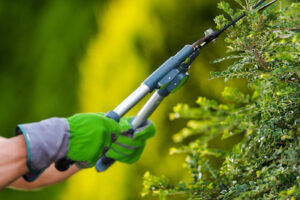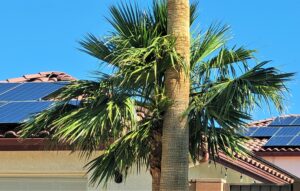Preparing Your Roof for the Bad Weather: Can It Handle a Falling Tree?
Your roof is your home’s first line of defense against the elements, and it’s important to make sure it’s up to the task of protecting you and your family during severe weather events. Storms, hurricanes, tornadoes, and other extreme weather conditions can cause significant damage to roofs, including falling trees, high winds, and heavy rain. So, how do you prepare your roof for the worst weather and make sure that it can handle a falling tree?
There are a few things to do when preparing your roof for the worst weather and making it to where it can handle a tree. Things such as regular inspections, checking your roof shingles, cleaning your gutters, trimming trees, reinforcing your roof, installing protective components, investing in a quality roof, and checking your insurance coverage.
In this post, we’ll talk about how to ensure you’re ready if tree falls on your roof. Read on to see how you can prepare your roof for storms, the worst weather, and falling trees and whether or not your roof can handle a falling tree so that you can keep yourself safe during the next big storm.

Preparing Your Roof for the Worst Weather Steps
These are all of the important steps to take to ensure that your roof is up to the task of the worst weather and potentially handling a falling tree:
1. Assess the Condition of Your Roof
Before you begin worrying about the potential of a tree falling on your roof and the damage it could possibly cause, it’s important to check the condition of your roof. How old is it? Was it properly installed by a professional? Is it showing any signs of weathered roofing materials? Is there any evidence of previous tree-related damage such as loose tiles or torn shingles? If you’re not exactly sure how to analyze all of that, don’t worry – hire an expert.
As one of the most important things you can do to prepare your roof for storms and severe weather is to have it inspected regularly. A professional roofing contractor can inspect your roof for any signs of damage or wear and tear, such as missing shingles, cracked tiles, or loose flashing. If any issues are found, they can be repaired before the next storm hits.
2. Check Your Roof Shingles
It’s also essential that you check the condition of your roof shingles before a storm hits. Look for loose shingles, cracks, or missing pieces that could be easily damaged by falling debris from a tree. If you find any problems with these components, it’s important to have them fixed right away so that they won’t be susceptible to further damage during bad weather conditions.
3. Check and Clean Your Gutters
During heavy rain or storms, clogged gutters can cause water to back up and overflow onto your roof, causing water damage and potential leaks. Regularly cleaning your gutters, especially before a storm can prevent this from happening. As well as helps ensure that water is properly directed away from your home while flowing freely without obstruction or blockage.
4. Trim Your Trees Regularly
Whether it’s strong storm winds or a snowy wintery storm, falling trees can wreak havoc on your roof. To avoid a post-storm disaster, make sure you’re regularly trimming your trees. By taking time to prune, you’ll have peace of mind that if one of your eucalyptuses decides to take off, it won’t be taking your roof down with it. Not only will pruning prevent damage that could cost thousands of dollars in repairs, but the likelihood of having an uninvited guest wake you up with a crash is considerably lower.

5. Reinforce Your Roof
Another way to prepare your roof for storms and extreme weather is to reinforce it. This can involve adding additional support beams or installing stronger roofing materials, such as metal or tile roofing. Reinforcing your roof can help prevent it from collapsing or being torn off during a storm, reducing the risk of damage to your home and property.
6. Install Protective Components
It may be wise to install protective components on your roof such as hurricane straps or clips. Hurricane straps are metal connectors that are used to secure the roof to the walls of your home. These straps can help keep your roof in place during high winds and prevent it from being lifted off your home, as well as being damaged by falling trees and other debris during extreme weather conditions. If you live in an area that is prone to hurricanes or severe storms, installing hurricane straps is a good investment.
Additionally, it may be beneficial to invest in impact-resistant windows and doors which can help minimize the amount of debris entering your home if a large tree falls nearby during a storm.
7. Invest In a Quality Roofing System
Protecting your home against the wrath of mother nature is no easy feat. Even if you think you’ve taken all the precautions necessary, such as staking down trampolines and netting over above-ground pools – there’s still no guarantee that a heavy gust of wind during storm season won’t send an unsuspecting tree crashing onto your roof. That’s why it’s essential to invest in a quality roofing system that can easily withstand any tree-related drama Mother Nature throws your way. Sure, it might cost you a little bit more money now – but trust me, it’ll be worth it if trees start raining from the sky.
8. Check Your Insurance Coverage
Even with proper preparation and maintenance, there is always a risk of damage to your roof during severe weather events. It’s important to check your insurance coverage to make sure you’re adequately protected in the event of a storm or other natural disaster. Review your policy to understand what is covered and what is not, and consider adding additional coverage if necessary.

Can Your Roof Handle a Falling Tree?
One of the biggest concerns during severe weather events is the risk of falling trees, which can cause significant damage to roofs and homes. Whether or not your roof can handle a falling tree depends on a number of factors, including the size and weight of the tree, the angle at which it falls, and the strength and durability of your roof.
If a falling tree lands directly on your roof, there is a high likelihood of damage or even collapse. However, the damage may be less severe if the tree falls nearby or glances off the roof. The best way to reduce the risk of damage from falling trees is to regularly trim trees around your home and ensure that they are healthy and stable.
In addition, reinforcing your roof can help it withstand the impact of falling trees or debris. Adding additional support beams, installing stronger roofing materials, and using hurricane straps can all help prevent your roof from collapsing or being torn off during a storm.
In Conclusion
It is important to make sure your roof is in top shape before a major storm hits. As preparing your roof for storms and extreme weather is essential for protecting your home and family from damage and potential harm. Taking the time to get your roof inspected by a professional can be the difference between not having to worry about a falling tree and dealing with the nightmare of roof repairs and damages. While there is always a risk of damage from falling trees or other debris, proper preparation can help minimize the impact and reduce the likelihood of severe damage.
